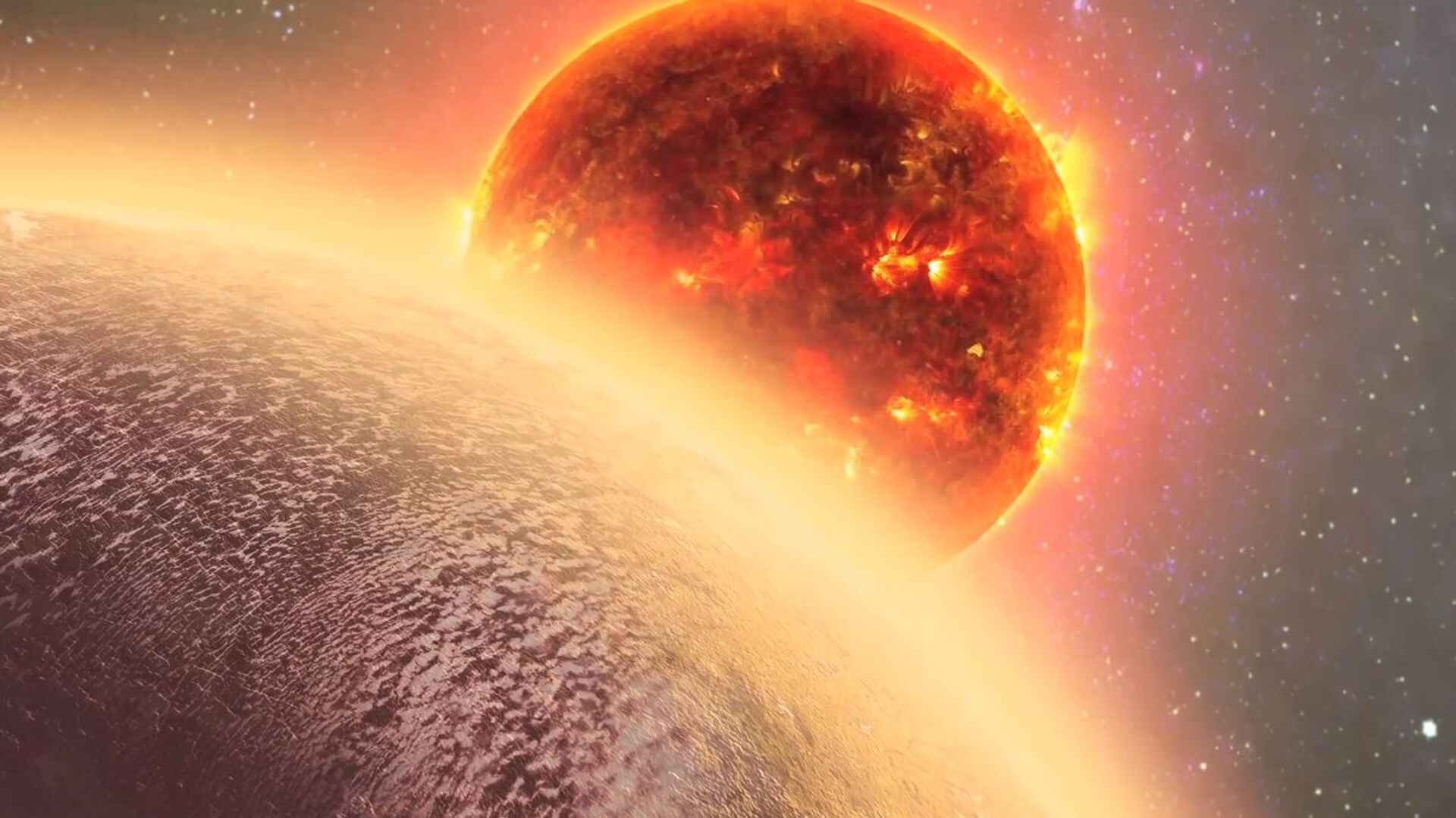https://sputniknews.in/20230530/indian-scientists-discover-gigantic-alien-planet-13-times-bigger-than-jupiter-2241006.html
Indian Scientists Discover Gigantic Alien Planet 13 Times Bigger Than Jupiter
Indian Scientists Discover Gigantic Alien Planet 13 Times Bigger Than Jupiter
Sputnik India
This is the third exoplanet to have been discovered from India, and by scientists from the Physical Research Laboratory (PRL) in Gujarat's Ahmedabad city.
2023-05-30T16:54+0530
2023-05-30T16:54+0530
2023-05-30T16:54+0530
science & tech
india
indian space research organisation (isro)
space exploration
extraterrestrial life
science & tech
ministry of earth sciences
https://cdn1.img.sputniknews.in/img/07e7/05/1e/2244880_0:8:1239:704_1920x0_80_0_0_cbd2f3aa292d2ba1e4f6c311f5fadaa7.jpg
An international team of scientists, led by Professor Abhijit Chakraborty from Gujarat's Ahmedabad city, have recently found a massive exoplanet which is touted to be over 13 times larger than Jupiter and has the highest density ever recorded. The newly discovered planet, named TOI4603b, also known as HD 245134, is located 731 light years away from planet Earth and rotates around a star every 7.24 days.Prof. Chakraborty from the Physical Research Laboratory (PRL) in Gujarat's Ahmedabad city, led a team of international scientists from Germany, Switzerland, and the US who utilized a cutting-edge indigenous spectrograph called PRL Advanced Radial-velocity Abu-sky Search (PARAS) at the Gurushikhar Observatory in Rajasthan state's Mount Abu. This ground-breaking technology allowed the team to make significant astronomical discoveries and measured the mass density of the planet, which was recorded 14 g/cm3.According to the study findings, the planet's mass ranges from 11 to 16 times that of Jupiter and is raging hot, with a temperature of 1,396 degrees Celsius. The Indian Space Research Organisation (ISRO) reacted to the recent discovery and said that what makes this discovery special is that the planet that falls into the transition mass range of massive giant planets and low-mass brown dwarfs.This extremely dense and massive giant planet orbits incredibly close to its host star - at a distance less than one-tenth of the distance between the Sun and the Earth. As scientists continue their search for extra-terrestrial life, they have made the remarkable discovery of over 5,000 exoplanets outside our solar system. These planets exhibit a variety of unique characteristics, such as differing atmospheres and properties, making each one a fascinating study for astronomers. Could one of these otherworldly bodies harbour the necessary conditions for life to exist? Only time and continued research will tell. In the meantime, the hunt for exoplanets and potential life forms beyond our planet will undoubtedly remain a key focus of scientists around the globe.
india
Sputnik India
feedback.hindi@sputniknews.com
+74956456601
MIA „Rossiya Segodnya“
2023
Sangeeta Yadav
https://cdn1.img.sputniknews.in/img/07e6/0c/0f/110602_0:0:641:640_100x100_80_0_0_c298016a79eb02ef8caa9d1f688c12a5.jpg
Sangeeta Yadav
https://cdn1.img.sputniknews.in/img/07e6/0c/0f/110602_0:0:641:640_100x100_80_0_0_c298016a79eb02ef8caa9d1f688c12a5.jpg
News
en_IN
Sputnik India
feedback.hindi@sputniknews.com
+74956456601
MIA „Rossiya Segodnya“
Sputnik India
feedback.hindi@sputniknews.com
+74956456601
MIA „Rossiya Segodnya“
Sangeeta Yadav
https://cdn1.img.sputniknews.in/img/07e6/0c/0f/110602_0:0:641:640_100x100_80_0_0_c298016a79eb02ef8caa9d1f688c12a5.jpg
indian scientists discover alien planet, indian scientists discover exoplanet, newly discovered exoplanet, professor abhijit chakraborty, massive exoplanet over 13 times larger than jupiter, newly discovered planet named toi4603b, hd 245134, journal astronomy & astrophysics letters, nasa's transiting exoplanet survey satellite, physical research laboratory, prl, cutting edge indigenous spectrograph, prl advanced radial-velocity abu-sky search, paras, gurushikhar observatory in rajasthan state's mount abu, astronomical discoveries, indian space research organisation, isro,
indian scientists discover alien planet, indian scientists discover exoplanet, newly discovered exoplanet, professor abhijit chakraborty, massive exoplanet over 13 times larger than jupiter, newly discovered planet named toi4603b, hd 245134, journal astronomy & astrophysics letters, nasa's transiting exoplanet survey satellite, physical research laboratory, prl, cutting edge indigenous spectrograph, prl advanced radial-velocity abu-sky search, paras, gurushikhar observatory in rajasthan state's mount abu, astronomical discoveries, indian space research organisation, isro,
Indian Scientists Discover Gigantic Alien Planet 13 Times Bigger Than Jupiter
This is the third exoplanet to have been discovered from India, and by scientists at the Physical Research Laboratory in Gujarat's Ahmedabad city.
An international team of scientists, led by Professor Abhijit Chakraborty from Gujarat's Ahmedabad city, have recently found a massive exoplanet which is touted to be over 13 times larger than Jupiter and has the highest density ever recorded.
The newly discovered planet, named TOI4603b, also known as HD 245134, is located 731 light years away from planet Earth and rotates around a star every 7.24 days.
The journal Astronomy & Astrophysics Letters published a study revealing that NASA's Transiting Exoplanet Survey Satellite (TESS) had initially identified the star TOI4603b as a possible host of a mysterious secondary object.
Prof. Chakraborty from the Physical Research Laboratory (PRL) in Gujarat's Ahmedabad city, led a team of international scientists from Germany, Switzerland, and the US who utilized a cutting-edge indigenous spectrograph called PRL Advanced Radial-velocity Abu-sky Search (PARAS) at the Gurushikhar Observatory in Rajasthan state's Mount Abu.
This ground-breaking technology allowed the team to make significant astronomical discoveries and measured the mass density of the planet, which was recorded 14 g/cm3.
According to the study findings, the planet's mass ranges from 11 to 16 times that of Jupiter and is raging hot, with a temperature of 1,396 degrees Celsius.
The Indian Space Research Organisation (ISRO) reacted to the recent discovery and said that what makes this discovery special is that the planet that falls into the transition mass range of massive giant planets and low-mass brown dwarfs.
This extremely dense and massive giant planet orbits incredibly close to its host star - at a distance less than one-tenth of the distance between the Sun and the Earth.
"The detection of such systems provides valuable insights into the formation, migration, and evolution mechanisms of massive exoplanets", the ISRO said.
As scientists continue their search for extra-terrestrial life, they have made the remarkable discovery of over 5,000 exoplanets outside our solar system. These planets exhibit a variety of unique characteristics, such as differing atmospheres and properties, making each one a fascinating study for astronomers.
Could one of these otherworldly bodies harbour the necessary conditions for life to exist? Only time and continued research will tell.
In the meantime, the hunt for exoplanets and potential life forms beyond our planet will undoubtedly remain a key focus of scientists around the globe.



